|
|
 |
Fiche d'espèce de Copépode |
|
|
Calanoida ( Ordre ) |
|
|
|
Calanoidea ( Superfamille ) |
|
|
|
Megacalanidae ( Famille ) |
|
|
|
Elenacalanus ( Genre ) |
|
|
| |
Elenacalanus sverdrupi (Johnson, 1958) (F) | |
| | | | | | | Syn.: | Bathycalanus sverdrupi M. W. Johnson, 1958 a (p.258, Descr.F, figs.F); Owre & Foyo, 1967 (p.34, Rem.); Björnberg, 1968 (p.81, Rem.); Michel, 1994 (p.186, Rem.); Andronov, 2014 (p.40, fig.: Mx2)
Ref. compl.: Grice & Hulsemann, 1967 (p.13) | | | | Ref.: | | | Bradford-Grieve & al;, 2017 (p.151, Descr. F, figs. F, Rem., Fig.114: depth range) | 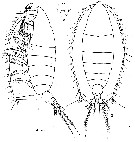 issued from : M. W. Johnson in Proc. Calif. Acad. Sc., 1958, XXIX (6) [p.259, Figs.1, 1a, 2]. As Bathycalanus sverdrupi. Female (from 12°33'N, 164°49'E): 1, habitus (lateral); 1a, rostrum (anterior aspect engarged scale); 2, habitus (dorsal). Nota: Head without crest and no horn-like process or sensory hairs. - A1 25-segmented, reaching the end of the caudal rami; terminal segment of A1 very short.
|
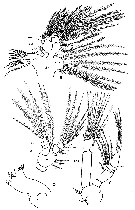 issued from : M. W. Johnson in Proc. Calif. Acad. Sc., 1958, XXIX (6) [p.261, Figs.3-6]. As Bathycalanus sverdrupi. Female: 3, Mx1; 4, Md (mandibyular palp); 5, Md (mandibular blade); 6, A2. b1 = 1st basis; b2 = 2nd basis; end = endopod; ex = exopod; L1-5 = external lobes; Li = internal lobes.
|
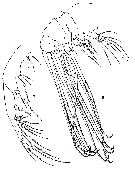 issued from : M. W. Johnson in Proc. Calif. Acad. Sc., 1958, XXIX (6) [p.262, Figs.7-8]. As Bathycalanus sverdrupi. Female: 7, Mxp; 8, Mx2 (L1-L5 = lobes of the bases).
|
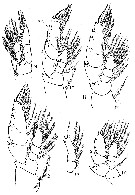 issued from : M. W. Johnson in Proc. Calif. Acad. Sc., 1958, XXIX (6) [p.263, Figs.9-14]. As Bathycalanus sverdrupi. Female: 9, P1; 10, P2; 11, P3; 12, P4; 13, exopod of P1 abnormal; 14, P5. Nota: The cutaneous pores of the ''maculae cribrosae'' (m.c) are arranged in clumps, not in an oval or ring.
|
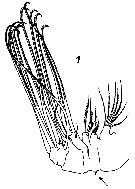 Issued from : V.N. Andronov in Russian Acad. Sci. P.P. Shirshov Inst. Oceanol. Atlantic Branch, Kaliningrad, 2014. [p.40, Fig.10, 1]. As Bathycalanus sverdrupi after Johnson, 1958. 1, Mx2.
|
 Issued from : J.M. Bradford-Grieve, L. Blanco-Bercial & G.A. Boxshall in Zootaxa, 2017, 4229 (1). [p.155, Fig.107]. Female (from USNM101078): A, Mx1 (posterior surface; B, Mx1 praecoxal arthrite (anterior surface); C, P1. Scale bars: 1.0 mm (C); 0.1 mm (A, B). Nota: - Anterior margin of forehead, in lateral view, projecting forwards and in dorsal view rostral branches partially visible. - In lateral view, posterior corners of pediger 5 rounded. - Genital double-somite swollen, symmetrical in dorsal view, much wider than long. - A1 not extending to caudal rami. - A2 exopod ancestral segment IV bearing short seta extending to segment VIII - Md basis with 3 setae (Johnson, 1958). - Mx1 praecoxal arthrite with 14 setae including 3 setae on posterior surface and 1 moderately long seta on anterior surface; coxal endite without setae; basal endites 1 and 2 with 2 and 1 seta, respectively; endopod segments with 1, 1, 4+1 small setae; basal exite without seta; epipodite with 7 long and 2 very short, reduced setae. - Mx2 with terminal setae curved distally in semicircle and extending beyond rostrum, setae on coxal endite 2 particularly well developed, curled in semicircle and of similar length to terminal setae. - Mxp syncoxa endite 4 longest seta extending beyond distal border of endopodal segment 2; endopodal segments 3-6 with 1, 1, 1, 2 setae respectively, apparently without any outer border setae on endopodal segments 5 and 6. - P1 exopodal segment 3 with 2 outer border spines, proximal spine broken on mounted leg and probably longer than that illustrated by Johnson (1958).
|
 Issued from : J.M. Bradford-Grieve, L. Blanco-Bercial & G.A. Boxshall in Zootaxa, 2017, 4229 (1). [p.91, Table 11]. Morphological characters after identification key of Elenacalanus females and males. Compare to other species of genus. Main characters identification after species key : 1 - Head without crest.. 2 - Mx1 basal endite 2 with 1 seta. (male unknown).
| | | | | NZ: | 3 | | |
|
Carte de distribution de Elenacalanus sverdrupi par zones géographiques
|
| | | | | | | Loc: | | | Gulf of Guinea, SW Indian, Pacif. (Marshall Is., depth: 2103 m)
Type locality: 12°33'N, 164°49'E. | | | | N: | 3 | | | | Lg.: | | | (405) F: 17-16,8; (140) F: 18; {F: 16,80-18,00} | | | | Rem.: | bathypélagique.
Le descripteur mentionne une longueur totale de 17 mm, et in Owre & Foyo (1967) 18 mm pour une femelle en profondeur dans le G. de Guinée, ce qui en font les plus grands calanoïdes connus. Mais non le plus grand des copépodes qui est Pennella balaenopterae (parasite siphonostome externe sur Balaenoptera physalus de l'Atlantique NE) avec des dimensions de 24 ± 2,6 cm chez les femelles ! (in Abaunza & al., 2001, p.196)
Voir aussi les remarques en anglais | | | Dernière mise à jour : 11/08/2018 | |
|
|
 Toute utilisation de ce site pour une publication sera mentionnée avec la référence suivante : Toute utilisation de ce site pour une publication sera mentionnée avec la référence suivante :
Razouls C., Desreumaux N., Kouwenberg J. et de Bovée F., 2005-2025. - Biodiversité des Copépodes planctoniques marins (morphologie, répartition géographique et données biologiques). Sorbonne Université, CNRS. Disponible sur http://copepodes.obs-banyuls.fr [Accédé le 04 décembre 2025] © copyright 2005-2025 Sorbonne Université, CNRS
|
|
 |
 |









